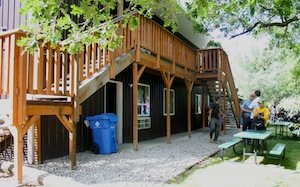Mike Omeg and his parents, Linda and Mel, employ 225 pickers during the height of the season at their orchards in The Dalles, Oregon, and can house all of them.
“Management of our seasonal labor force in harvest is a critical component of us being successful farmers,” Mike told growers during the annual Oregon State University cherry tour last week. “It’s probably more important than it was in the past when picking labor was abundantly available.”
Mike said he and his family expect that labor will become one of their major concerns, as seasonal workers become more difficult to recruit. They depend almost entirely on Hispanic workers, and the flow of workers from Mexico has slowed partly because of stricter immigration enforcement.
The Omegs have long provided housing and continually upgrade their camps to ensure that the facilities are assets to the farm.
“We’re thinking of our camp not as a giant hassle we have to deal with, but as an asset to weather the upcoming challenges we have with recruitment and retention of seasonal workers at harvest,” Mike said. “I think you have to have that attitude to be successful. The people who come to pick our cherries are going to be more and more selective.”
Treat workers fairly
But Omeg said it’s not just a competitive issue—the family wants to treat workers fairly. That means paying close attention to what goes on in the labor camps so that everyone is happy and comfortable staying there.
“A group of rowdy folks can really ruin the experience for people who just want to come and focus on getting the job done and going home with a good paycheck,” he said. “We have policies for our camp that we think are important for the entire camp to run smoothly.”
One rule is that alcohol is not allowed outside the cabins. At first, that was a hard sell, he said, but everyone seems to like the policy now, and it’s eliminated problems with groups of young men drinking and getting into conflicts with each other.
Another rule is that visitors are only allowed within certain hours, which avoids the problem of strangers coming to the camp to hang out.
Prizes are offered to encourage residents to recycle as much of their garbage as possible. This has reduced the Omegs’ garbage costs tremendously. Plus, it’s a good thing to do, Mike noted.

George Vorhauer, occupational safety consultant with the Oregon Department of Consumer and Business Services, said most fruit growers in the Mid-Columbia area do a good job with their housing, but the Omegs are among a few who have gone above and beyond the legal requirements just out of compassion for the workers.
“They believe the folks that go out and work in their orchards should have a nice, clean place to go back to,” he said.
Overall, the most common problem he sees with worker housing is overcrowding. Under Occupational Health and Safety Administration regulations, a certain square footage must be provided for each worker.
For facilities built before 1985, areas where workers eat, live, and sleep must measure 65 square feet per person. If a separate eating area is provided, only 40 square feet per person are required for living and sleeping. For housing built after 1985, 100 square feet are needed for areas used for eating, living, and sleeping. In 2018, facilities of any age will need 100 square feet per person.
Another change coming in 2018 is a requirement that the ceiling of living areas be at least 7 feet high. Vorhauer said this is likely only to affect housing with second-story attics where the ceiling slopes down to less than seven feet at the walls.
Site requirements can also be difficult to comply with, Vorhauer said. For example, the grass should be mowed and garbage emptied. There should be enough toilets and laundry facilities for the number of occupants, and they need to be kept clean. Campfires must be at least 25 feet away from buildings and livestock at least 100 feet away.
Vorhauer, who is based at the Pendleton field office, said Oregon growers can request free consultations from the department to make sure their housing meets all the regulations. This is often done before growers operate new housing or after they have made major changes.
Consultations are kept entirely separate from enforcement activities, and the grower usually has 30 days to bring the facility into compliance. For information or to schedule a consultation, e-mail Vorhauer or call him at (541) 276-2353.


Leave A Comment